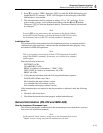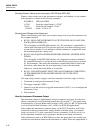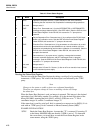
2620A, 2625A
Users Manual
4-16
Sending Numeric Values to the Instrument (RS-232 and IEEE-488)
Numeric values can be sent to the instrument as integers, real numbers, or real numbers
with exponents, as shown in the following examples:
EXAMPLE EXPLANATION
+12345 Sends the signed integer “+12345”
123.45 Sends the real number “123.45”
-1.2345E2 Sends -1.2345 x 10
2
Sending Input Strings to the Instrument
Observe the following rules when you construct strings to be sent to the instrument over
the computer interface:
• RULE 1: READ THE INSTRUMENT’S OUTPUT BUFFER ONLY ONCE FOR
EACH QUERY COMMAND.
This rule applies to the IEEE-488 interface only. The instrument’s output buffer is
cleared after it has been read. This prevents previously read data from being read a
second time by mistake. If you attempt to read the instrument’s output buffer twice
the instrument generates a query error.
• RULE 2: READ QUERY RESPONSES BEFORE SENDING ANOTHER INPUT
STRING.
This rule applies to the IEEE-488 interface only. Output data remains available in
the output buffer until it is read by the host or until the next input string is received
by the instrument. This means the instrument’s output buffer must be read by the
host before, rather than after, the next input string is sent to the instrument.
Otherwise, unread data in the buffer is overwritten.
• RULE 3: THE INSTRUMENT EXECUTES EACH COMMAND COMPLETELY,
IN THE ORDER RECEIVED, BEFORE MOVING ON TO THE NEXT
COMMAND.
If an input string contains a trigger, enter the commands from left to right, as follows:
1. Commands to configure the instrument (if any).
2. The trigger command (*TRG).
3. Queries to read the result of a triggered measurement (LAST?), or to reconfigure the
instrument (if any).
4. The terminator.
How the Instrument Processes Output
The instrument outputs an alphanumeric string in response to any query from the host.
(Query commands are easily identified because they all end with “?”.) An output string
is terminated by a Carriage Return and Line Feed (<CR> <LF>) for RS-232 applications
or a Line Feed with End or Identity (<LF> <EOI>) for IEEE-488 applications.
After sending the instrument a command string via the RS-232 interface, wait for the
instrument to return a prompt before sending another command string. (A command
string can consist of 1 or more syntactically correct commands.) If you do not do so, a
device-dependent command error is generated, and the second string is discarded.
If the instrument is used in an IEEE-488 bus system, the output data is not actually sent
onto the bus until the host addresses the instrument as a talker. When the output buffer is


















